Emotional Control or Compromise?: On Mulvey and Vertigo
In her 1975 work of feminist theory “Visual Pleasure and Narrative Cinema,” Laura Mulvey attempts to make sense of the inherent misogyny present in Hollywood, basing her arguments on fundamental concepts in Freudian and Lacanian psychoanalytic theory. Her argument centers around four key concepts: scopophilia (which can become fetishistic), the male gaze, anxieties associated with castration, and voyeurism. Scopophilia is, literally, the love of looking, and for Mulvey, this takes on a sexual connotation as this act often has a sexual element to it. Likewise, the male gaze is the filter through which women are viewed in film and are “styled accordingly” in order to please the desires of the objectifying male subject (62). The men need to act as the subject due to their castration anxieties, an idea she extrapolates from a reading of Sigmund Freud. She claims that
The male unconscious has two avenues of escape from this castration anxiety: preoccupation with the re-enactment of the original trauma (investigating the woman, demystifying her mystery), counterbalanced by the devaluation, punishment or saving of the guilty object (an avenue typified by the concerns of the film noir); or else complete disavowal of castration by the substitution of a fetish object or turning the represented figure itself into a fetish so that it becomes reassuring rather than dangerous (hence over-valuation, the cult of the female star). (65)
This definition refers back to the topic of scopophilia, but escalates it to a level of fetishism, which presents an obsession with the female form that goes beyond the normal, socially acceptable erotic interest. The other avenue aims to make the female the perpetrator of some unknown sins, sins which, in the heteronormative world of Hollywood, only men can absolve by implementing some sort of “punishment.”
In this essay, Mulvey highlights the insecurities associated with subjugating potentially “threatening” female characters. Apart from briefly waxing philosophical on the potential of Alfred Hitchock’s 1958 thriller Vertigo being a proto-feminist work, however, she does not give adequate consideration to two of the most significant aspects of the film: how does the film’s universe respond to women when they try to be above the male gaze and what would happen should the male character not be strong enough to exert his “authority” over the stereotypically objectified female characters? If one were to apply Mulvey’s claims to these vertiginous gender relationships, certain things undeniably line up, but Mulvey’s complex argument still appears not complex enough to handle the spiraling and psychologically thrilling tale that unfolds. Vertigo’s female leads, Marjorie “Midge” Woods (Barbara Bel Geddes) and Madeleine Elster/Judy Barton (Kim Novak), have the potential to turn the preconceptions of their society on their heads. Due to the oppressive need of the film’s universe to portray the metaphorically impotent John “Scottie” Ferguson (James Stewart) as superior in every regard, however, the film eventually gives up its innovative message and reverts to the comfortable stereotypes of old.
Midge Wood: The Lovelorn
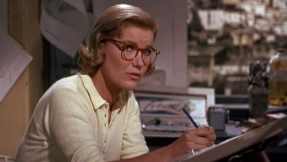
Midge, Scottie’s former fiancée, represents a woman who is both willingly subjected to the male gaze and above its influence. In their first scene, once Scottie begins to question her about her love life, she brushes him off with tongue-in-cheek quips such as “You know there’s only one man in the world for me, Johnny-o” (Vertigo). Despite her claims to the contrary, it is obvious that Midge is still in love with him and she is not subtle in the slightest about this fact. When Scottie asks her if she knows anyone who knows about the history of San Francisco, she is willing to drop everything to help him. “In a world ordered by sexual imbalance, pleasure in looking has been split between active/male and passive/female. The determining male gaze projects its fantasy onto the female figure, which is styled accordingly,” Mulvey explains, highlighting in particular the passivity of typical female characters and their desirability as a result of this passivity (62).
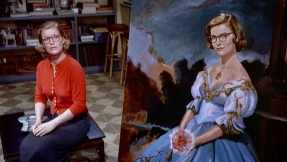
When it comes to her feelings for Scottie, Midge is willing to be passive if that’s what he wants her to be, but it is clear that she is struggling to fit herself into that perfect image of submissive innocence. This is further reinforced when Midge openly expresses her readiness to conform to Scottie’s desires by painting herself into the portrait of Carlotta Valdes. Although she is expressing her willingness to be passive, her means are too active, and so Scottie outright rejects her, even though they share a romantic past. In fact, this move on her part is so outlandishly active that he is insulted by it, telling her that the matter is “not funny” and quickly excusing himself from her apartment (Vertigo). The two never converse again in the rest of the film. It would seem as if Midge has stepped out of bounds in this moment, and the film reprimands her as a result.
After this episode occurs with the portrait, Midge clearly feels remorse for what she does, as she gets angry at herself as soon as Scottie has left. She gave no thought to what his feelings would be like when she created this perverse token of her love and affection for him, which causes her to seem somewhat detached from the plethora of emotions which Scottie experiences in excess. Her last scene of the film occurs when Scottie is in the sanitarium. She tries in vain to communicate with him, but he is long gone at this point, so when she says “Ah, Johnny-o…you don’t know I’m here, do you? […] But I’m here,” it is a beyond heartbreaking moment, as her simple words mean so many things (Vertigo).
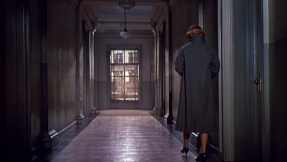
Midge has been there all along, but Scottie became so obsessed with his projection of perfection onto Madeleine that he failed to realize it. As she leaves the sanitarium and tells the attending doctor that Scottie is still in love with Madeleine, even though she’s gone, she bows her head and walks painstakingly slowly down an absolutely vacant corridor, a long shot executed with such melancholy that it is clear that not only is she walking out of the film at this point, she is also walking out of Scottie’s life. As Midge is not and will never be the subject of Scottie’s “determining male gaze,” a film so consumed by the importance of appearances has no place for her (62).
In all of her scenes, Midge is displayed as more capable than Scottie. At the beginning film, she is the working woman while Scottie lays reclined, wearing a corset. At the film’s end, Midge is the only one who has the strength and good sense to walk away before it is too late. It is because of this revolutionary strength and independence that the film ultimately does not know what to do with her. How can a supporting female character be more competent than our heroic male protagonist? Doesn’t that idea fundamentally go against the wish-fulfillment that Hollywood strives to satisfy? These are questions for which Vertigo’s only answer is to plead the fifth.
Madeleine Elster: The Damsel
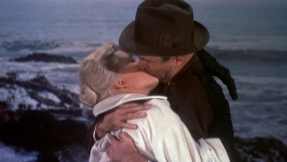
The film’s discomfort with active female characters is only strengthened when one takes into consideration the duplicitous Madeleine/Judy. When we first meet Madeleine Elster, she is the textbook example of passivity. Using Mulvey’s term, everything about Madeleine caters to the male gaze. She wears gorgeous gowns, appears passive in almost everything she does, and gives the impression that she needs a male figure to save her, particularly in the instance when she leaps into San Francisco Bay. Scottie, of course, is all too willing to be her knight in shining armor, even though his masculinity is far past its prime. Following his rescue, a rushed but passionate affair begins between the two, but the film leads the viewer to believe that their relationship ends in tragedy as Madeleine commits suicide in front of Scottie’s eyes.
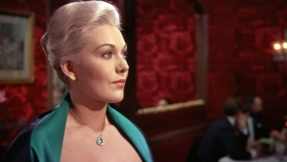
In Mulvey’s essay, she states that “In their traditional exhibitionist role women are simultaneously looked at and displayed, with their appearance coded for strong visual and erotic impact so that they can be said to connote to-be-looked-at-ness” (62-63). This is particularly exemplified in the film in two brief, but noticeable moments. When Scottie first lays eyes on Madeleine, he views her from behind, most of her back exposed by the elegant gown she wears to dinner with her husband and her hair perfectly pinned back in a bun, which in turn exposes the column of her neck, a particularly sensual body part. As she approaches Scottie when they leave the restaurant, both Scottie and the viewer get a close up view of her profile and flawlessly pale, smooth skin, the pallid hue existing in stark contrast with the overpowering crimson of the restaurant’s walls. This objectification repeats itself soon after when, just as she checks in to the McKittrick Hotel, Madeleine is viewed by Scottie primarily in profile through one of the room’s windows. Her curves are the main focus, and additionally, dressed in white, she represents the innocence and purity ascribed to typical submissive female characters. Everything about Madeleine’s appearance in these two moments “connote[s] to-be-looked-at-ness.” On a first viewing, it appears as though Madeleine’s character is very limited, for she is viewed entirely from Scottie’s love struck perspective.
Judy Barton: The Manipulator, Manipulated
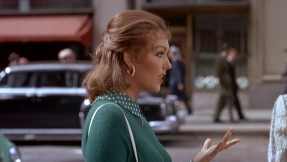
As soon as Judy Barton is introduced into the narrative, matters only become all the more disheartening. When we first meet her, everything about Judy exudes life. Her bronze hair, crimson lipstick, and vibrantly green gown parallel her robust character. She is immediately much more active than Madeleine ever showed potential of being, telling Scottie that he has “got a nerve, following [her] right into the hotel and up to [her] room! […] Beat it!” (Vertigo) All throughout this scene, she has her hand on the door, ready to shut Scottie out, and yet she never does, hinting at the disappointing weakness that the film’s universe will ultimately fall back on. Even though Judy is much more independent than Madeleine ever was, as soon as Scottie enters into her hotel room, she cowers and backs away from him as though she is the prey being stalked by the predator. The power imbalance between them is as disconcerting ever and perhaps even more so now since this is who Judy really is and not a part she is playing.
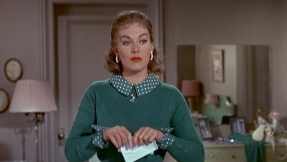
In a scene only viewed by the audience and not Scottie, Judy begins to reconsider all of her actions as she is overwhelmed with emotions. She considers telling Scottie the truth, even going so far as to write a letter explaining everything, which is in a way seeking the “punishment or saving of the guilty object” that Mulvey highlights in her definition of voyeurism (65). She attempts to act out against the oppression of this universe in which she lives, and yet for some unknown reason, she is unable to go through with it. The same universe that has no place for Midge also has no place for Judy’s desire to be in control and this ultimately proves to be Judy’s downfall. From this moment on, Judy gradually submits herself to Scottie, as Mulvey highlights in her own interpretation of the film:
He reconstructs Judy as Madeleine, forces her to conform in every detail to the actual physical appearance of his fetish. Her exhibitionism, her masochism, make her an ideal passive counterpart to Scottie’s active sadistic voyeurism. She knows her part is to perform, and only by playing it through and then replaying it can she keep Scottie’s erotic interest. (67)
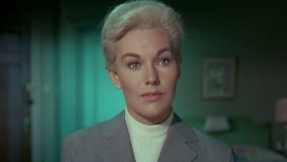
When Scottie is done with “reconstructing” Judy, any signs of her hearty character are long gone. Her hair is bleached to the point that it may as well be white and her wardrobe consists of drab gray and black suits that hide her form. Judy’s fate is doomed to repeat itself in a world where drastic change is ultimately impossible.
Scottie Ferguson: The Hero?
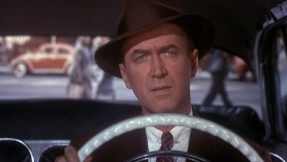
Why is it that these perfectly competent and capable female characters so willingly subject themselves to the authority of a male figure who is not at all strong enough to exert any sort of control over them? Scottie, who is meant to be our protagonist and a hero in the true masculine sense, is in fact the passive and over sensitive one. He fails to act throughout most of the film, and even his job as detective is a rather passive one, for all he does is trail behind Madeleine as a sad puppy follows its owner. This seems to hold true for the film’s primary storyline which takes up more than half of its length, but following Scottie’s release from the sanitarium, things invert and the typical misogynistic views regain control of a film that was headed in the right direction—a direction which was, in fact, unusual for the film’s time.
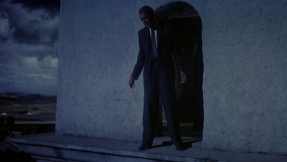
Additionally, Mulvey claims that a woman “also connotes something that the look continually circles around but disavows: her lack of a penis, implying a threat of castration and hence unpleasure” (64). Applying this supposition to Vertigo does not entirely work. It is not the women who represent the threat of castration for Scottie, but it is he who enacts his own castration. At three times over the course of the film, Scottie is powerless to prevent the same horrific fate from befalling three different people: a fellow police officer, the real Madeleine Elster, and Judy Barton all fall to their deaths under his watch. He is incapable of keeping alive those about whom he cares, signifying a sort of impotence. He cannot guarantee that life will continue, for even as he “saves” Madeleine from San Francisco Bay, he later realizes that Judy is most likely “really a strong swimmer,” since she was never in any real danger at all (Vertigo). If he cannot perpetuate life, there is no way in which he can create it, which hampers his masculinity and emphasizes his social castration. Despite being the film’s hero (or, perhaps, anti-hero), Scottie is heroically impotent due to his own acrophobia, a condition imposed upon himself which he is unable to overcome.
Vertigo makes a valiant effort to present fully developed, independent women who exert their power over men without being entirely sexualized; however, as the plot complicates with each repetition, this effort seems to get lost somewhere along the way. In the first half of the film, Midge is strong and self-confident, and Judy, as Madeleine, is competent and convincing. Yet as history begins to repeat itself, the stereotypes that Mulvey criticizes in her essay begin to appear in rapid succession. Judy entirely allows herself to be the object of Scottie’s active, perverse, and obsessive control and Midge gives up all of her gumption and resigns herself to leaving Scottie’s life. In a quotation that Mulvey herself uses, Budd Boetticher claims:
What counts is what the heroine provokes, or rather what she represents. She is the one, or rather the love or fear she inspires in the hero, or else the concern he feels for her, who makes him act the way he does. In herself the woman has not the slightest importance. (63)
Hitchcock’s women strive to be three-dimensional, but ultimately, the universe in which the film takes place is unsure of how to coalesce the desire for independence with the inherently misogynistic society. Societal pressure wins in the end and the women resume their roles as flat caricatures in sharp contrast with the fully thought out and nuanced male protagonist.
Works Cited
Vertigo. Dir. Alfred Hitchcock. Perf. James Stewart, Kim Novak, Barbara Bel Geddes, and Tom Helmore. Paramount Pictures. 1958. Film.
Mulvey, Laura. “Visual Pleasure and Narrative Cinema.” Feminist Film Theory: A Reader. (1999): 58-69.
What do you think? Leave a comment.











Alfred Hitchcock, in my opinion, was not only a master of suspense but also of satire. His movies point to the foibles and vulnerability of many of his characters, both male and female.
Hitchcock’s aim, in all his film- making, was to please the female audience! He reasoned that so long as the wives and sweethearts were interested in seeing the films, the husbands and boyfriends would shell out the ticket price.
I’m all for gender equality and respect for women and I am a biiig hitchcock fan.
It’s not a crime for an artist to have little interest in women, or to display them unfavourably.
I love Laura Mulvey, and this is a great application of her ideas. It’s really fascinating to see the effect she’s talking about played out in movies today as well as in the classics; it really shows that next to nothing has changed. She says in her paper that essentially any woman who enjoys movies like this is a masochist, which I think that’s a little harsh, but I get what she’s saying. This character formula presents a fundamentally degrading image of women that seeks to affirm a primarily patriarchal expectation of the world, which I would say is, in some ways, absolutely a crime. That said, I still think it’s definitely possible to understand why these films are problematic and still appreciate them for what they are. Those aren’t mutually exclusive ideas. Awesome article!
*which I think is a little harsh 😛
I couldn’t agree more with you regarding appreciating the films but still understanding why and how they’re problematic and why that matters. I find that generally summarizes my feelings on much of Hitchcock’s body of work, many of which are some of my favorite films on the level of purely being wonderful works of cinema, but also because they are so interesting to analyze and discuss. 🙂 Thanks for the great comment!
Are you a film studies student by any chance kdaley? Your analysis is brilliantly constructed with great depth. A fantastic read. 😀
I’m actually an English/Creative Writing student, but I’ve taken a few film classes and it’s really become a passion of mine on the side. 😀 Thank you for the wonderfully kind words!
Interesting read, I was wondering if Mrs. Hitchcock had and any influence on roles of the females you identified in this film?
Going purely based on Alma Reville’s credits as listed on IMDb, she wasn’t technically involved in the making of Vertigo at all, although she is credited with the screenplay or adaptation for some of his earlier films such as Shadow of a Doubt and Suspicion. Whether she subconsciously/inadvertently/habitually influenced any of these characters, we can’t really know, but it’s still a wonderful question to think about. Although, upon further inspection, a quick Google search for “Alma Reville Vertigo” does bring up a very telling publicity still for Vertigo of Alma doting on Hitchcock as he sits at his desk poring over documents, perhaps the script. That simple photo may say quite a lot. 🙂
I’m a huge Hitch fan and also a feminist.
A lot of his women are, to put it nicely, problematic.
I find the women in his earlier films are comparatively better.
The niece in Shadow of a Doubt — one of his early American films — is quite intelligent, strong-willed, independent and brave. Teresa Wright is fantastic in the role, one of my favorites.
I also find Shirley McLaine’s character in The Trouble With Harry hilariously immune to 1950s suburban housewife cliches. I love Stranger on a Train but the less said about the women in that film, the better.
Then there’s Stage Fright – Jane Wyman plays, again, a very resourceful brave, intelligent young woman. Then of course there’s Notorious.
And then there’s Ingrid basically carrying Gregory Peck on her back all by herself in Spellbound. She commands the entire film – solves the mystery, keeps Peck from cracking up and never gives up. Again, also a very intelligent woman. Lots of Hitch’s women were very intelligent. Even the problematic ones (like the ones in Marnie, Psycho and North by Northwest).
Kim Novak in Vertigo… She wasn’t even his choice for the role. The women in his later films are not at all memorable for some reason – Topaz, Torn Curtain, Family Plot, Frenzy.
Both the old lady and the young female lead in The Lady Vanishes are also good, strong characters.
At least the women are interesting!
Strong article. bold, well researched, and exhaustive in its scope. a good read.
Hitchcock made films with drama so that they would be interesting and people would want to watch them, rather than setting out a parade of feminist role models.
Hitchcock made great suspense films.
I feel Hitchcock wanted to envoke thought in his audience as to what is at the heart of many male and female relationships; and although a woman maybe physically inferior to a man, many are tower over men emotionally and psychologically.
Hitch’s women are imperfect, because perfect people don’t make for good films. But we might more reasonably ask what’s wrong with his men, given that they’re supposed to be the heroes. In the later films at least they tend to be a seriously creepy lot, thanks to the depth of performances he got from the likes of Grant (going upstairs with a glass of milk, with a light in it, for Joan Fontaine, or pimping Ingrid Bergman) and Stewart (almost psychotic in his manipulation of Kim Novak).
View his films with their cultural/ historical context in mind; realise they’re thrillers, so extrordinary people and behaviour are to be expected, and marvel at their technical brilliance.
Hitchcock’s fetishistic need to mould such strong, morally upstanding men-folk in his films whilst literally rubbing dirt into the faces of anyone with a hemline is just dastardly.
Is it at all possible that a film made about straightforward, honest, hard-working, capable, independent, diligent, creative women who don’t get into any kind of trouble or have any drama in their lives, because they are so sensible that they avoid it all, would be just dull and not dramatic?
His women were multifaceted, as opposed to the empty headed pretties that were all the rage at the time. He was very much a feminist.
Alfred Hitchcock’s women in his films have always been a topic of discussion when you discuss his films. He always has an attractive blonde in mind to play each role before he even starts filming.
I think Hitchcock uses a lot of irony in his movies. It’s ironic that Sean Connery’s character in Marnie is supposed to be the leading man/hero but he evilly rapes his wife. It’s ironic that Scottie Ferguson in Vertigo is presented as an accomplished detective but in the opening scene he lets the criminal get away and is presented as more and more inept as the movie goes on. The male characters in these two movies might be multidimensional but they aren’t very successful. In Psycho, Norman Bates is a hero? More irony. He’s the main character but he doesn’t have the qualities any sane person would qualify as heroic. Also since an argument for a patriarchal hero might include violence, Norman Bates’ violent acts signify how insane patriarchal violence is.
If Hitchcock’s movies were really presenting a case for patriarchy wouldn’t the characters be more cardboard and one dimensional? At least in the two cases above the characters seem to be hinting at another (loser) side to the stereotyped category of “hero”. Can’t we make the argument that the patriarchal category of “hero” is destabilized in the insanity of Psycho, Marnie and Vertigo? I agree that Midge leaves the story line because her common sense character isn’t congruent to the insanity of Scotty.
I don’t know that I am answering any questions but this seems like a start.
“I agree that Midge leaves the story line because her common sense character isn’t congruent to the insanity of Scotty.” I meant, her common sense isn’t compatible with Scottie’s insanity.
I find the extrapolation of this so called “male gaze” idea being to objectify women and “fear of castration” more-or-less over-simplified nonsense at least as it applies to the character of Scottie Ferguson in ‘Vertigo’. He’s a *detective*, hired to follow and watch a woman’s every move. His initial attraction to “Madeleine” (and accepting the assignment) is admittedly based solely on her appearance but to suggest that’s a “man thing” is just plain silly when women choose men like that all the time. If a theory is propped up by attributing some self-imposed importance to it, perhaps because of one’s own personal fears, it becomes far easier to adapt what one sees in art to fit that hypothesis, ignoring the fact that, on closer inspection, “the shoe simply doesn’t fit”. It’s an “easy way out” of having to truthfully answer why we think and behave the way we do: By assigning a group (or gender in this case) who make us victims and perhaps feel less individually culpable. Ironically those personal motives being confused with what is right or altruistic, is what Vertigo is *really* about.